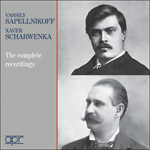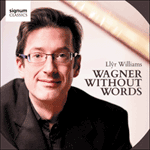The
Zwei Stücke aus ‘Tannhäuser’ und ‘Lohengrin’, of which the
Einzug der Gäste auf der Wartburg is the first piece, first appeared in print in 1853. For the reissue in 1876 Liszt made a few alterations to the first number, and in subsequent editions, the original text is usually printed with the later alterations as footnotes. Since the ternary structure of the transcription entails a large literal repeat, it is possible to include the details of the later edition (not the variant simplifications) in the repeated section without doing any violence to the work. This repeat is, in any case, Liszt’s own invention to round off the work as a concert piece; in the opera—Act 2 Scene 4, the Song Contest at the Wartburg—the march and chorus move into a further slower march for the entry of the minstrels, which music recurs in another key towards the end of the scene. Liszt turns these two 32-bar periods into a trio section and composes a brilliant modulating return to a shortened version of the march.
from notes by Leslie Howard © 1998
Les
Zwei Stücke aus «Tannhäuser» und «Lohengrin», dont l’
Einzug der Gäste auf der Wartburg constitue la première pièce, furent imprimés pour la première fois en 1853. Pour la réédition de 1876, Liszt apporta quelques modifications et les éditions subséquentes proposent généralement le texte original avec les altérations ultérieures en bas de page. La structure ternaire de la transcription exigeant une grande répétition littérale, il est possible d’inclure les détails de l’édition postérieure (mais pas les diverses simplifications) dans la section répétée sans faire violence à l’œuvre. Cette reprise est, de toute manière, une invention de Liszt pour clore l’œuvre en tant que pièce de concert; dans l’opéra—Acte II, scène 4, le concours de chant à Wartburg—, la marche et le chœur se meuvent en une marche plus lente encore pour l’entrée des ménestrels, que la musique reproduit dans une autre tonalité, vers la fin de la scène. Liszt transforme ces deux périodes de trente-deux mesures en une section en trio et compose une brillante reprise modulante d’une version abrégée de la marche.
extrait des notes rédigées par Leslie Howard © 1998
Français: Hypérion
Die
Zwei Stücke aus „Tannhäuser“ und „Lohengrin“ erschienen erstmals 1853. Das erste Stück daraus ist der
Einzug der Gäste auf der Wartburg. Im Rahmen einer Neuausgabe im Jahre 1876 nahm Liszt am ersten Stück einige Änderungen vor. In folgenden Ausgaben erscheint der Originaltext gewöhnlich mit den späteren Änderungen als Fußnote. Da der dreiteilige Aufbau der Transkription zu einem großen Teil eine wortgetreue Wiederholung darstellt, ist es möglich, Elemente der späteren Ausgabe (nicht aber die diversen Vereinfachungen) in den Wiederholungsabschnitt einzubeziehen, ohne dem Werk dabei zu schaden. Jedenfalls ist diese Wiederholung Liszts eigener Beitrag zur Abrundung des Werks als Konzertstück. In der Oper (2. Akt, 4. Auftritt) gehen beim Liederwettbewerb auf der Wartburg der Marsch und der Chor zum Einzug der Sänger in einen weiteren, langsameren Marsch über, und die Musik kehrt gegen Ende der Szene in einer anderen Tonart wieder. Liszt verwandelt diese beiden Abschnitte mit je 32 Takten in ein Trio und schafft eine brillant modulierte Rückkehr zu einer verkürzten Fassung des Marsches.
aus dem Begleittext von Leslie Howard © 1998
Deutsch: Michael Stoffl


 Liszt: Complete Piano Music
Liszt: Complete Piano Music Vassily Sapellnikoff & Xaver Scharwenka - The complete recordings
Vassily Sapellnikoff & Xaver Scharwenka - The complete recordings Wagner: Wagner without words
Wagner: Wagner without words
